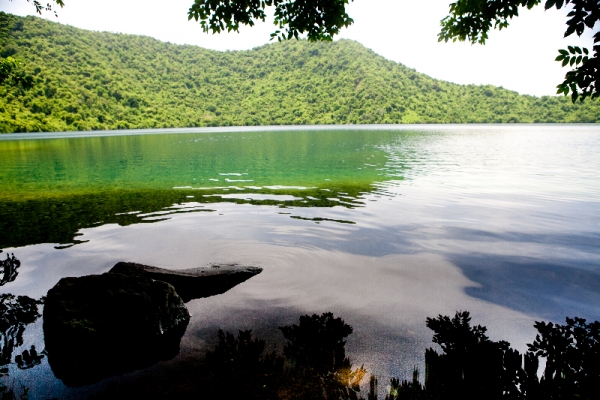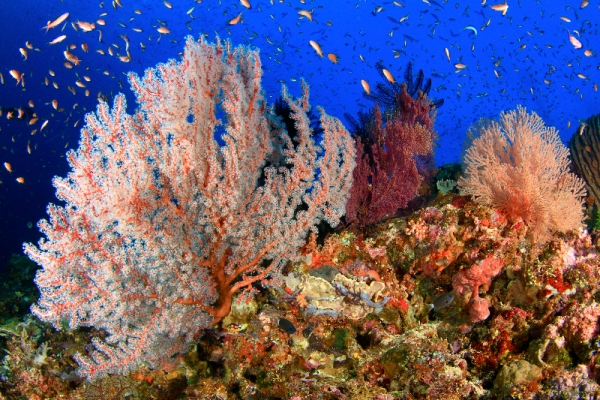Bali to Komodo/Komodo to Bali
Embarcarse en Benoa Harbour, Bali, que está a poca distancia de Kuta o Sanur, the Indo Aggressor will sail heading east, que pasa y buceo a las islas interesantes antes de llegar a Parque Nacional de Komodo. Este pasaje se hace solamente un par de veces al año, por lo que es una experiencia única de bucear y navegar a lo largo del camino de Bali a Komodo. Además, sino que también le ahorrará un viaje en el vuelo doméstico.
Satonda – Where is it?
* Un poco al oeste del archipiélago indonesio
* 8 grados 7 minutos al sur del ecuador, 117 degrees east
* 164 nautical miles east of Bali
* Between the islands of Sumbawa and Flores
Satonda, Norte Sumbawa
Una pequeña isla sin inhibiciones en el norte,sólo off shore de Sumbawa, que tiene un cráter de dos abarca la mitad del tamaño de la isla. Originalmente, el agua del lago era agua dulce, pero debido a tsunami como resultado de Mt. Tambora explosión en 1815, el agua del lago se ha convertido Satonda salado, clearing the myth that it is due to the tunnel below the lake surface which has been thought of by many people.
Sangeang – Where is it?
* Noreste costa de Sumbawa
* 8 grados 18 minutos al sur del ecuador, 119 degrees east
* 206 nautical miles east of Bali
* Entre Bali y Flores
La isla de Sangeang formas 13 kilómetros de ancho, con dos volcanes activos. Doro API mide la altura de más de 1,900 sobre el nivel del mar, mientras Doro Mantoi es aproximadamente 1,800 metros sobre el nivel del mar. Es un espectáculo para la vista majestuosa del buque.
La isla está rodeada por un arrecife sobre una base de arena negro. Hay varios sitios de buceo alrededor de la isla. Algunos de ellos son bastante único, con ventilación de gases calientes en el agua. Hot Rocks es uno de estos sitios.
Gili Banta
We make the short trip over from Sangeang to Gili Banta and anchor in the calm and secluded bay that makes up the north shore of Gili Banta. This large island sits all on its own at the top of the Sape Strait, the 20 nautical mile wide channel that separates the eastern end of Sumbawa from the mythical island of Komodo and the majority of the islands dive sites are located in and around this expansive north facing bay. On closer inspection the high peaks and ridges that are a feature of the higher parts of the island appear to be the eons old remains of a caldera that formed the jagged peaks of a huge volcano.
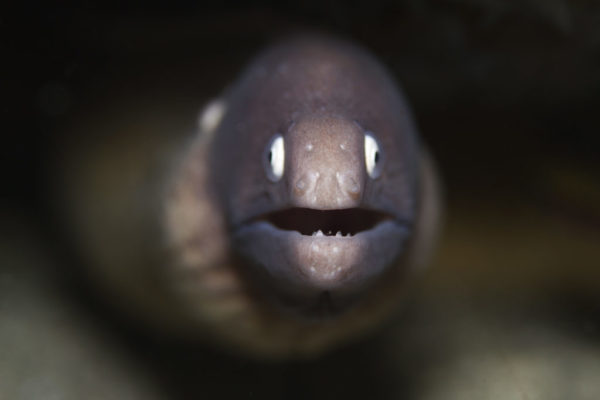
Gili Banta is a fantastic place to dive with something for everyone. On the one hand we have the high adrenalin sites of Rollercoaster and GPS Point which on their day produce incredible dives with big Þsh and magniÞcent coral covered scenery around the jaw dropping marine architecture. On the other there is the remarkable Circus dive site that promises a great array of critters, in particular the elusive stargazer, during a night dive over the sand and corals.
Gili Lawah Mar, Norte Komodo
Yesterday we were on the extreme western boundary of the Komodo National Park, today we are inside it at two of the very best locations, Lawah Gili Gili Lawah Mar y Tierra, two mountainous islands extending to the north Komodo mainland.
These islands feature some of the most popular and very best dives in the park, Crystal and Castle Rocks, two thrilling seamounts and two high voltage current dives at Shotgun and GLD Passage.
The beaches at both of the islands are easy to get onto too and it is possible, if a little exhausting, to trek up to the summits of both of them following a variety of easy to spot trails.
El estrecho Linta
Today we are diving right in the thick of the national park, the very nerve centre of current opera ons, the Linta Strait. The two bodies of water on either side of the Nusa Tenggara archipelago, the Savu and Flores Seas have a four mes a day Þght for supremacy up and down this scenic waterway, the channel that separates Komodo from Rinca Island and mainland Flores.
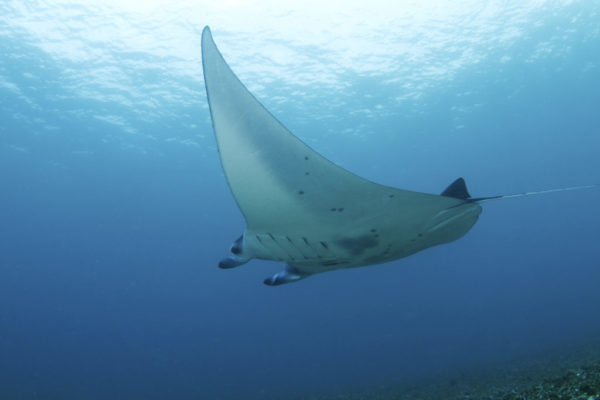
This constant throughflow of nutrient rich water is what makes Komodo and other parts of Indonesia very special for divers creating a marine wonderland full of corals reefs over which a rich variety of marine wildlife preside, and the Linta Strait is one of best places in the country to see all this interaction. Drift dives, manta dives and very special seamount dives are a highlight of a visit to what is also commonly called Current City.
Horseshoe Bay
From the wonders of the Linta Strait we motor down for a couple of hours to arrive at what can only be described as The Land That Time Forgot. Waking up to Þnd the Komodo Dancer safely anchored in the calm waterway at Horseshoe Bay is a me travelling experience. As dawn breaks there is a commo on on the beach as packs of crab ea ng macaques squabble with each other, deer and pigs also roam around looking for fresh water and a snack while pods of dolphin play and hunt the shore. Up in the air white bellied sea eagles and brahminy kites swirl in the thermals also looking out for breakfast but the main a rac on has yet to wake up. We are of course talking about the mythical Komodo Dragons and Horseshoe Bay is one of the best places in the park to get up close and personal with these ferocious creatures as they patrol the forest fringed nearby beaches.
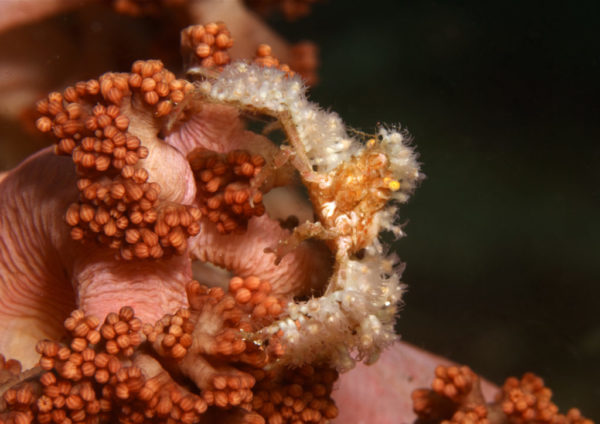
Horseshoe Bay is located at the southern end of Rinca Island and would be open to the elements of the Savu Sea were it not for the massive high rocky island of Nusa Kode that sits in the middle. Nusa Kode creates a wide river like waterway that runs out into the open sea from two entrances which on rising and falling des funnel the nutrient rich waters from the deeper ocean outside all around the bay to create one of the most prolific marine environments on the planet. World renowned sites like Cannibal Rock and Yellow Wall are just a couple of the outrageously colourful and critter packed dives that abound in and around this magical part of the natural world while a night dive at Torpedo Alley is an experience not to be missed for the critter enthusiast.
Langkoi/Padar
After the excitement of Horseshoe Bay we motor due west to carry on our cruise in two completely different environments, the first is the wild and rocky Langkoi Bay, more reminiscent of the Galapagos than Indonesia. Like a twin of Horseshoe Bay, Langkoi covers the centre southern section of Komodo Island, the only difference being that it does not have a huge island in the middle of it, but rather several sets of very jagged spume splashed rocky outcrops. There are some fantastic dives here in the wild west but the main attraction at Langkoi are the groups of manta rays that gather here to feed and be cleaned, some mes in large numbers, when a plankton bloom occurs. These majestic animals can be seen patrolling around these wave battered outposts almost year round and a mornings diving here can be the highpoint of any Komodo cruise.
Over lunch it is me to move over to the island of Padar. This is the third largest island in the park sitting between Komodo and Rinca and features one of the prettiest anchorages in the area as well as some great critter packed dives sites.A topside highlight of a visit to Padar is the short and easy land excursion to one of the islands unique pink beaches to watch the sun set over Komodo across the Linta Strait.
Wainilu
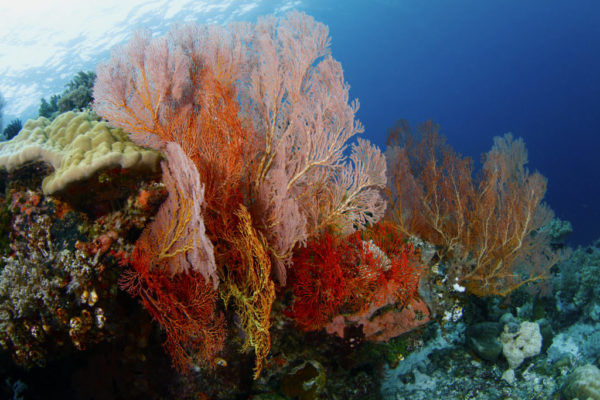
Today is our last opportunity to dive the amazing Komodo National Park. We have several choices open to us now, we can stay at Padar to dive at the coral covered set of seamounts at W Reef, we can dive some more at either Gili Lawah Laut or further explore the Linta Strait, the park is our oyster….. But one thing is for sure, in the afternoon we will visit the National Park headquarters at either Komodo or Rinca islands.
After our two morning dives its time to let your gear dry and once again go on shore to hunt for more of the parks splendid array of flora and fauna. Our trek today will be led by an experienced and knowledgeable park ranger before heading back to the Indo Aggressor for a last day cocktail party, cruise presentation and farewell dinner.
Labuhanbajo Harbour, West Flores
Después de un corto crucero de vuelta a Occidente Flores vamos a desembarcar en el puerto de la ciudad bonita de Labuhanbajo para el corto trayecto hasta el aeropuerto y el vuelo de regreso a Bali.
Por favor, tenga en cuenta: Este itinerario es sólo un ejemplo y que a veces puede visitar las diferentes áreas de las indicadas en este documento y siempre operamos con un ojo en las condiciones meteorológicas y del mar, así como las expectativas de vida marina.


